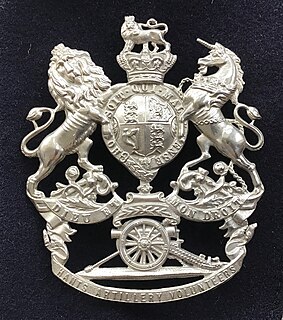
The 44th Siege Battery was a unit of Britain's Royal Garrison Artillery (RGA) raised during World War I. It manned heavy Railway guns supporting the British Expeditionary Force on the Western Front from 1916 to 1918, seeing action on the Somme, at Vimy Ridge and at Cambrai. A distant successor unit continues in the present-day Royal Artillery.

The 1st Cornwall Artillery Volunteers were formed in 1860 as a response to a French invasion threat. They served as a Coast Artillery unit during both World Wars, and also manned batteries serving overseas. The unit continued in existence until the dissolution of Coast Artillery in the UK in 1956.

The 96th Siege Battery was a unit of Britain's Royal Garrison Artillery (RGA) raised during World War I. It manned heavy howitzers on the Western Front from 1916 to 1918, beginning with the Attack on the Gommecourt Salient on the First day on the Somme.

The 121st Siege Battery was a unit of Britain's Royal Garrison Artillery (RGA) raised during World War I. It manned heavy howitzers on the Western Front from 1916 to 1918.

The 172nd Siege Battery was a unit of Britain's Royal Garrison Artillery (RGA) raised during World War I. It manned heavy howitzers on the Western Front and Italian Front from 1916 to 1918.
The 1st Carnarvonshire Artillery Volunteers was a part-time unit of the British Army in North Wales from 1862 to 1922. It fought on the Western Front in World War I. Postwar it was amalgamated with the Denbighshire Hussars as a medium artillery regiment that served in World War II.

The Pembroke Royal Garrison Artillery was a part-time unit of the British Army that defended the coast of West Wales during both world wars. Although it never saw action in its coastal defence role, it manned a number of siege batteries of heavy howitzers for service on the Western Front and Italian Front in World War I.

171st Siege Battery was a unit of Britain's Royal Garrison Artillery (RGA) formed during World War I. It served on both the Western Front, including the Battles of Arras and Passchendaele, and the Italian Front, where it participated in the repulse of the Austrian Summer Offensive of 1918 and the crushing victory at Vittorio Veneto.

The 8th Lancashire Artillery Volunteers was a unit of the British Volunteer Force raised in Liverpool, Lancashire, in 1860. Later it transferred to the Territorial Force as a brigade of heavy artillery, and its batteries fought in many of the great battles on the Western Front in World War I.

The North Scottish Royal Garrison Artillery and its successors were Scottish part-time coast defence units of the British Army from 1908 to 1961. Although the unit saw no active service, it supplied trained gunners to siege batteries engaged on the Western Front during World War I.

67th Siege Battery, was a heavy artillery unit of the Royal Garrison Artillery (RGA) formed in Scotland during World War I. It saw active service on the Western Front at the Somme, Arras, Ypres, and in the final Hundred Days Offensive.

110th Siege Battery was a heavy howitzer unit of the Royal Garrison Artillery (RGA) formed during World War I. It saw active service on the Western Front at the Somme and Cambrai, against the German spring offensive, and in the final Hundred Days Offensive.

The Forth Royal Garrison Artillery and its successors were Scottish part-time coast defence units of the British Army from 1908 to 1956. Although they saw no active service, they supplied trained gunners to siege batteries engaged on the Western Front during World War I.

70th Siege Battery, was a heavy howitzer unit of the Royal Garrison Artillery (RGA) formed during World War I. It saw active service on the Western Front at the Somme, Vimy Ridge and Cambrai, against the German spring offensive, and in the final Hundred Days Offensive.

114th Siege Battery, was a heavy howitzer unit of the Royal Garrison Artillery (RGA) formed in Wales during World War I. It saw active service on the Western Front at the Somme, Vimy Ridge and Ypres, against the German spring offensive, and in the final Hundred Days Offensive.

The 1st Hampshire Artillery Volunteers and its successors were part-time coast defence units of the British Army from 1860 to 1967. Although the units saw no action, they protected the Portsmouth area in both World Wars and supplied trained gunners to siege batteries engaged on the Western Front during World War I. The unit continued in the Territorial Army after World War II.

The 1st Dorsetshire Artillery Volunteers and its successors were part-time coast defence units of the British Army from 1859 to 1956. Although these units saw no action, they protected the Dorset Coast, including the naval base of Portland Harbour, in both World Wars and also supplied trained gunners to siege batteries engaged on the Western Front during World War I. The unit continued in the Territorial Army after World War II.

123rd Siege Battery was a unit of Britain's Royal Garrison Artillery (RGA) formed in 1916 during World War I. It served on the Western Front, including the Battles of Arras, Passchendaele, Cambrai and the crushing victories of the Allied Hundred Days Offensive in 1918. Post war, the battery was disbanded in 1919.

174th Siege Battery was a unit of Britain's Royal Garrison Artillery (RGA) formed during World War I. It served on the Western Front, including the Battles of Arras, Messines and Passchendaele, and the crushing victories of the Allied Hundred Days Offensive in 1918.

142nd (Durham) Heavy Battery was a unit of Britain's Royal Garrison Artillery (RGA) formed during World War I from coast defence gunners of the Durham Royal Garrison Artillery. It served on the Western Front, including the Battles of Vimy Ridge, Passchendaele, the Lys, and the crushing victories of the Allied Hundred Days Offensive in 1918.









